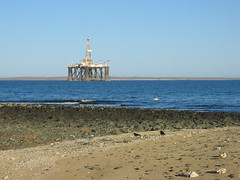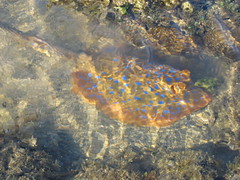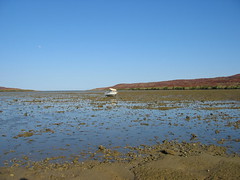Natural Gas Release - Gorgon Awakening
Posted by Big Gav
 Bloomberg notes that exploration in Australia is focussing on natural gas, as oil finds and reserves dwindle, and Energy Bulletin reports that Shell is now moving ahead with the Gorgon gas project in north west WA.
Bloomberg notes that exploration in Australia is focussing on natural gas, as oil finds and reserves dwindle, and Energy Bulletin reports that Shell is now moving ahead with the Gorgon gas project in north west WA.
The $11 billion Gorgon gas project, off the West Australia coast, moved a step closer yesterday with project partner Shell saying it had finalised the sale of 2.5 million tonnes of Gorgon LNG (liquefied natural gas) a year to the US west coast.
Last week the Gorgon project was restructured after ExxonMobil agreed to add its massive Jansz gas discovery - Australia's biggest single known reservoir - into the development.
Going ahead with this project will continue the minerals and energy boom going on in WA. Looking at it from an investment point of view, and given that local oil and gas companies don't have much of a stake in the Gorgon project, the best way to make some money on it for Australian investors is via the oil and gas services sector - specifically WorleyParsons (WOR.AX), Monadelphous (MND.AX) and PCH (PCG.AX).
 There has been a lot of opposition to this project going ahead over the years (although I suspect the main impediment has been the difficulties encountered in signing up a long term customer). Martin Hastings calls the project "Ugly by name, ugly by nature" - this is a good background piece and raises a whole lot of interesting questions.
There has been a lot of opposition to this project going ahead over the years (although I suspect the main impediment has been the difficulties encountered in signing up a long term customer). Martin Hastings calls the project "Ugly by name, ugly by nature" - this is a good background piece and raises a whole lot of interesting questions.There are many boundaries being tested with the Gorgon Gas project. This project has commercial, technical, geoscientific, economic, legal, political, geographic and timing elements involved, some of which appear to ‘jump the gun’ on co-operative international agendas that are currently being worked on. There are 2 separate projects on the go here that have been rolled into one development. This has blurred the lines about what is being proposed and turned a scientific discussion that has previously been publicly rejected on more than one occasion into an economic one with a much better chance of success.
The project involves far more than just the development of an isolated, deepwater, sour gas reservoir on an ‘A’ class nature reserve.The second project proposed at Gorgon involves the subterranean storage/disposal of approximately 5 million tonnes a year of CO2 into an underground aquifer. This element of the overall development constitutes a world first and is highly controversial given the history of geologic waste disposal in Australia and the proposed storage location. Currently, there are no laws, rules, indemnities or precedents in place that relate to what is being proposed in this project. Should the project receive final approval then the State government will have to introduce a regulatory framework that is applicable in law. By doing so they will in/advertently also create the necessary legal framework for the subterranean disposal/storage of other more noxious substances, ones that have been rejected in the past, at least in the public eye. This bifurcation is further explored in the article on carbon sequestration in this issue.
When looked at objectively almost every aspect of the proposed CO2 sequestration urges caution and further research to prove up the basic concept, yet here we are with in principle State government approval for the proposed location, subject only to final approvals and production of an environmental impact assessment. The EPA has already advised against the project taking place on Barrow Island but their advice has been ignored by the State government.
 The whole issue of carbon sequestration is unusual and I'm not sure what to make of it. The implication that it won't just be CO2 that gets dumped in there is a bit unsettling, but there have been a lot of proposals to dump nuclear waste here that have all been derailed eventually.
The whole issue of carbon sequestration is unusual and I'm not sure what to make of it. The implication that it won't just be CO2 that gets dumped in there is a bit unsettling, but there have been a lot of proposals to dump nuclear waste here that have all been derailed eventually. I am a bit dubious about the issue of general environmental destruction on Barrow Island as a result of constructing a new LNG plant. Having heard the same concerns voiced about the Burrup penninsula, I was expecting to find a toxic wasteland there when I visited 18 months ago - but in reality the plant didn't seem all that large in the context of the local environment, and didn't seem to have made that much of an impact on the surrounding area - the air seemed clean enough, the water had plenty of wildlife in it and the aboriginal rock art in the surrounding area seemed in the same condition as elsewhere.
I am a bit dubious about the issue of general environmental destruction on Barrow Island as a result of constructing a new LNG plant. Having heard the same concerns voiced about the Burrup penninsula, I was expecting to find a toxic wasteland there when I visited 18 months ago - but in reality the plant didn't seem all that large in the context of the local environment, and didn't seem to have made that much of an impact on the surrounding area - the air seemed clean enough, the water had plenty of wildlife in it and the aboriginal rock art in the surrounding area seemed in the same condition as elsewhere. The large flare from the plant was the most obvious problem, but even that had an upside for those stupid enough to get stranded by the tide when trying to make a run through a strait and later having to make their way home in the darkness.
The large flare from the plant was the most obvious problem, but even that had an upside for those stupid enough to get stranded by the tide when trying to make a run through a strait and later having to make their way home in the darkness. Compared to the iron ore port at Dampier and the salt processing works near Karratha it all seemed pretty clean - I'm happy to be corrected with any evidence to the contrary but complaints about environmental impact seemed pretty overblown.
Compared to the iron ore port at Dampier and the salt processing works near Karratha it all seemed pretty clean - I'm happy to be corrected with any evidence to the contrary but complaints about environmental impact seemed pretty overblown.Update: Removed a section about "flaring off" from the Gorgon project that I'd misread in Martin's article - apologies for any confusion caused.
Technorati tags: peak oil





